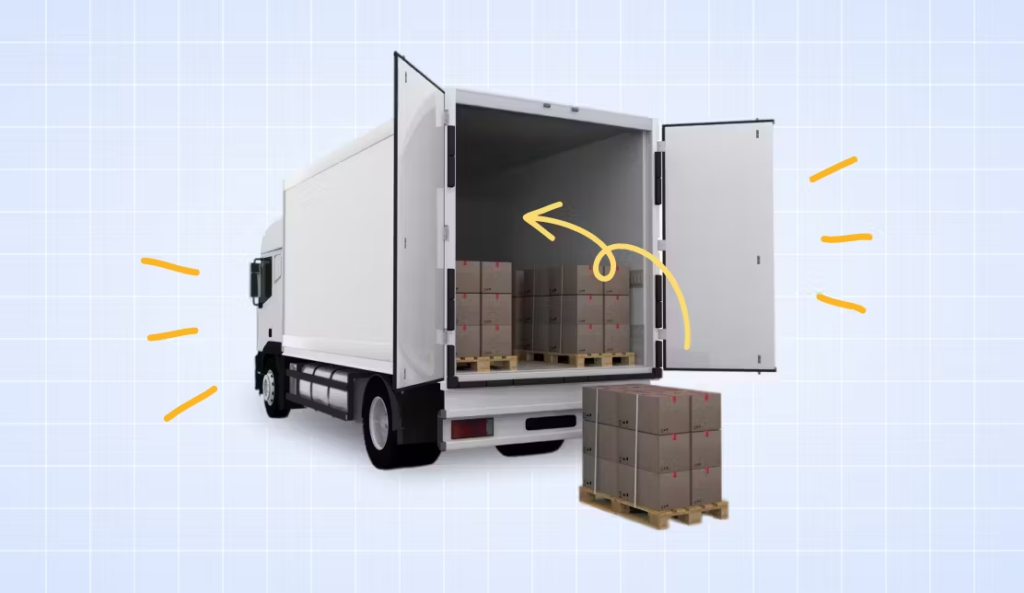
Shipping large items can be a daunting task, requiring careful planning and attention to detail. Whether you’re moving furniture, equipment, or other bulky goods, ensuring their safe and efficient transportation is crucial. In this guide, we will provide you with valuable tips and insights to help you navigate the process of shipping large items with confidence.

Additionally, we will discuss the benefits of utilizing professional shipping services specializing in large item transportation. These experts possess the expertise, equipment, and network to handle even the most complex shipments. We will provide guidance on selecting reputable companies and highlight the advantages they offer, such as tracking capabilities, insurance options, and efficient delivery.
How to pack large items?

When it comes to packing large items, careful planning and proper techniques are essential to ensure their safe transportation. Whether you’re moving or shipping oversized furniture, appliances, or other bulky objects, the following tips will help you pack them securely.
Assess and Plan for Packing Large Items
Before you begin packing, take the time to assess the specific requirements of each large item. Consider its size, weight, fragility, and any disassembly possibilities. This evaluation will help you determine the appropriate packing materials and techniques needed.
Disassemble and Organize Parts
If possible, disassemble large items to make them easier to pack and transport. Take note of the individual components and ensure they are organized and labeled appropriately. Keep all screws, bolts, or small parts in sealed bags and attach them securely to the corresponding item.
Gather the Right Packing Materials
When packing large items, you’ll need sturdy and appropriately sized packing materials. Start by acquiring high-quality moving boxes that can accommodate the size and weight of each item. Additionally, gather packing tape, bubble wrap, furniture blankets, packing paper, and other protective materials to safeguard your belongings.
Wrap and Protect Fragile Components
For large items with fragile parts, take extra care to protect them during transit. Use bubble wrap or packing paper to wrap delicate surfaces, such as glass doors or ornamental elements. Secure the wrapping with packing tape to prevent it from shifting or unwrapping during handling.
Cover Corners and Edges
To prevent scratches and damage to corners and edges, cover them with furniture blankets or moving pads. These protective layers act as a buffer, reducing the risk of impact-related injuries. Secure the blankets or pads firmly using packing tape or stretch wrap.
Provide Full Coverage with Protective Material
Depending on the item’s fragility, consider wrapping it entirely with bubble wrap or furniture blankets. This provides an additional layer of cushioning and protection against bumps or impact during transportation. Ensure the wrapping is secure and well-taped.
Utilize Proper Packing Techniques
When loading large items into the boxes, use appropriate lifting techniques and, if necessary, seek assistance. Lift with your legs and avoid straining your back. If the item is too heavy or bulky, consider using a dolly or hand truck to facilitate the process safely.
Secure the Item Inside the Box
Place the large item carefully in the box, making sure it fits snugly without excessive movement. If there is remaining space, use packing paper, foam peanuts, or inflatable air cushions to fill the gaps. This helps to prevent shifting and provides extra protection during transit.
Seal and Label the Box
Once the large item is securely in the box, close and seal it with sturdy packing tape. Reinforce all seams and edges to ensure the box remains intact throughout the journey. Don’t forget to label the box clearly with the item’s name and any handling instructions.
Consider Professional Assistance
For exceptionally large or valuable items, it may be wise to seek professional assistance. Movers or shipping services experienced in handling oversized objects can provide specialized packing materials, techniques, and secure transportation options to ensure the safety of your belongings.
What is the best and cheapest ways to ship heavy and large items?

There are several cost-effective methods to ship heavy and large items.
Here are two popular options:
Freight Shipping:
LTL (Less Than Truckload) Freight: LTL shipping is suitable when you have items that don’t require a full truckload. Your shipment will be combined with other shipments to fill the truck, reducing costs.
FTL (Full Truckload) Freight : FTL shipping involves booking an entire truck for your shipment. This option is cost-effective for large, heavy items that fill a truck on their own.
Freight Brokerage Services: Utilize freight brokerage services to connect with carriers and negotiate better rates. Brokers can help you find the most affordable shipping options for your specific needs.
Shipping Marketplaces and Comparison Websites:
Shipping Marketplaces: Platforms like uShip allow you to list your shipment and receive bids from various carriers. You can compare prices and choose the most cost-effective option.
Comparison Websites: Websites such as Shiply or Freightos provide price comparisons from multiple shipping providers. These platforms help you find the best rates for shipping heavy and large items.
In addition, businesses have to focus on the following factors:
Packaging: Properly package and protect your items to minimize the risk of damage during transit. Use sturdy boxes, bubble wrap, and padding materials as needed.
Weight and Size Optimization: Try to minimize the weight and size of your shipment whenever possible. Consider disassembling large items or removing unnecessary parts to reduce costs.
Plan Ahead: Booking your shipment in advance can help you secure better rates and avoid any last-minute rush fees.
Insurance: Consider purchasing insurance for your shipment to protect against any damage or loss. Compare insurance options to find the best coverage at a reasonable cost.
Remember, prices and availability of shipping options can vary, so it’s advisable to research and compare multiple options to find the best and cheapest solution for your specific shipment requirements.
Important Considerations When Shipping Large Items

When it comes to shipping large goods, there are several crucial considerations to keep in mind. Whether you are moving furniture, machinery, or any other bulky item, understanding the unique challenges and requirements of shipping oversized cargo is essential. In this guide, we will explore the key factors that demand attention to ensure a smooth and successful shipping process for large items.
Packaging and Protection
Proper packaging and protection play a vital role in safeguarding large goods during transit. When shipping bulky items, it is important to use sturdy and durable packaging materials that can withstand the rigors of transportation. Consider using heavy-duty cardboard boxes, wooden crates, or pallets to provide structural support and prevent damage.
Furthermore, invest in adequate padding materials such as bubble wrap, foam, or air cushions to cushion and protect fragile components. Secure the items within the packaging to prevent shifting or movement during transit. Label the packages clearly with appropriate handling instructions to ensure careful handling and minimize the risk of mishandling.
Compliance with Weight and Size Restrictions
Large goods are often subject to weight and size restrictions imposed by shipping carriers and transportation regulations. It is crucial to understand and comply with these limitations to avoid potential delays, additional charges, or even shipment rejection.
Before shipping, accurately measure and weigh the item to determine its dimensional weight and actual weight. Familiarize yourself with the carrier’s guidelines and restrictions for oversized items. If necessary, consider disassembling or removing any detachable parts to reduce the size and weight of the shipment. By ensuring compliance with weight and size restrictions, you can prevent unexpected complications and ensure a smooth shipping process.
Documentation and Customs Considerations
When shipping large items internationally, proper documentation and compliance with customs regulations become even more critical. Ensure that you have all the necessary shipping documents, including invoices, packing lists, and any required permits or licenses. Accuracy and completeness of these documents are essential to prevent customs clearance delays and potential penalties.
Research and understand the customs regulations of the destination country. Determine if any specific import duties, taxes, or restrictions apply to your large items. Engage the services of a customs broker if needed, as they can provide expertise in navigating the complex customs procedures and help ensure smooth clearance for your shipment.
Choosing the Right Shipping Method
Selecting the appropriate shipping method is crucial when transporting large goods. Consider factors such as cost, transit time, and the nature of your items when making this decision.
Freight shipping, including less-than-truckload (LTL) or full-truckload (FTL) services, is often a reliable choice for large item transportation. Freight carriers have the necessary equipment and expertise to handle oversized cargo. Alternatively, ground shipping services can be cost-effective for domestic shipments, especially when using specialized carriers experienced in handling heavy and large items.
For international shipping, air freight may be suitable for urgent deliveries, while ocean freight is a more economical option for larger shipments with longer transit times. Evaluate each method’s pros and cons, considering your budget and specific requirements, to make an informed choice.
Shipping large items requires careful consideration of packaging, compliance with weight and size restrictions, documentation, customs regulations, and choosing the right shipping method. By paying attention to these important considerations, you can ensure the safe and efficient transportation of your oversized items. Properly packaging and protecting the goods, adhering to weight and size restrictions, completing necessary documentation, and selecting the most appropriate shipping method will contribute to a successful shipping experience for your large items.
Whether you are a business owner shipping commercial goods or an individual relocating personal belongings, mastering the art of shipping large items can save you time, money, and unnecessary stress. Let’s dive into the following sections, where we will equip you with the knowledge and tools necessary to ensure the smooth and successful transportation of your oversized items.